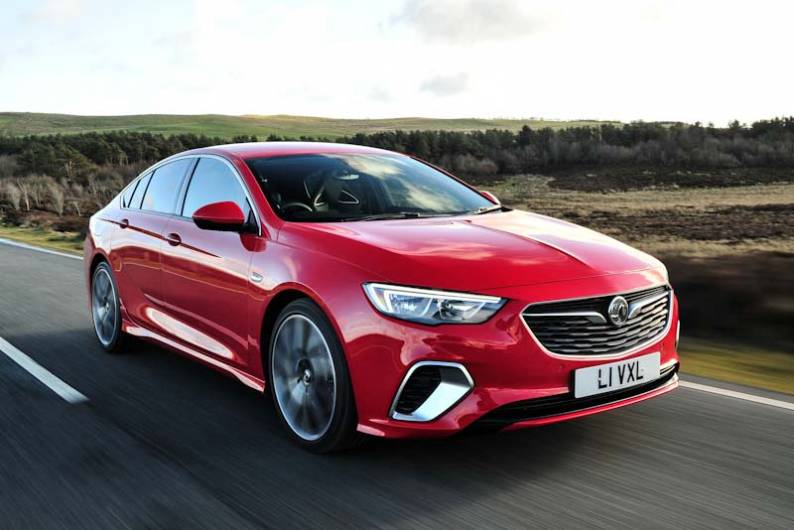
RAC sale – up to 33% off*
• Roadside cover from £5.29 a month†
• We get to most breakdowns in 60 mins or less
• Our patrols fix 4/5 breakdowns on the spot

By Jonathan Crouch
Introduction
It's decades now since GSi versions of standard Vauxhall models delivered rewardingly sharp handling without unnecessary and inefficient increases in power. In 2018, this Insignia GSi tried to revive that formula and did so with petrol and diesel power in a manner that'll surprise those used to the laid-back demeanour of the standard version. Power, after all, is nothing without control.
Models
Models Covered: (5-door hatch / Sports Tourer estate) [2.0 petrol / 2.0 diesel])
History
Vauxhall has a very creditable history when it comes to high performance versions of its sporty mainstream models and some of the very best of them were made in the Eighties and Nineties sporting 'GSi' badges. That's a moniker the company revived at the launch of this car in early 2018 to replace previous 'VXR' branding that the company then decided to reserve for more extreme models. 'GSi' Vauxhalls, in contrast, offered a slightly more sensible spin on high performance - which is why this Insignia GSi was the Luton maker's very first sporting model to offer the option of diesel power.
Driving enthusiasts might find themselves feeling a touch underwhelmed at this news - and perhaps a little disappointed that the 210PS BiTurbo 2.0-litre diesel engine in question was simply carried over from existing flagship Insignia models in the standard range. For a brief period in 2018, this diesel version sold alongside a 260PS 2.0-litre petrol turbo variant. In both cases, the AWD system and the 8-speed automatic transmission were simply borrowed from existing Insignia models. But don't lose interest just yet, because plenty else was different.
Ex-DTM Champion Volker Strycek and a crack team of engineers were briefed to take this fairly standard package and create something really special from it. They lowered the car, gave it bigger brakes with grippier tyres and added stiffer springs that work through a bespoke FlexRide adaptive damping system with an extra 'Competition' setting. There was even a twin clutch differential for the rear axle which allowed more torque to be sent to the outside rear wheel when cornering. All of this was honed throughout an extensive development programme at the classic Nurburgring Nordschleife racetrack, a circuit the 260PS petrol version of this model could lap an astonishing 12 seconds quicker than its much more powerful 325PS 2.8-litre V6-engined Insignia VXR model predecessor.
In 2020, a mid-term Insignia update saw the diesel version of this GSi dropped but the petrol version return, albeit with a lower 230PS output. It wasn't enough though, to see this fast Insignia through its final years and the car left the price lists when the Insignia range was dropped in mid-2020.
What You Get
Vauxhall's GSi branding is supposed to designate a slightly less extreme approach than was characterised by the old VXR badging but this seriously sporting Insignia still has plenty of street side presence. This body shape's sweeping style borrowed heavily from the company's Monza concept car, first exhibited at Frankfurt back in 2013 and in terms of size, you'll find this second generation Insignia to be significantly larger than the previous generation model, regardless of your preference between Sport Tourer estate or the alternative Grand Sport hatch.
Up front, the key GSi differentiation point lies with the extrovert chromed air intakes you'll find on each corner of the re-profiled bumper with its wide, body-coloured lower splitter. Move to the side and if you're a potential buyer, you'll probably note the way that this GSi variant's sports chassis sits 10mm lower than lesser derivatives, a demeanour emphasised by the sculpted side sills. The wheels are the largest you can have on an Insignia, the bespoke 20-inch rims lighter than those used elsewhere in the range, embellished with Brembo callipers and clad with grippy Michelin Pilot Sport 4-S rubber.
Take a seat inside and if you don't happen to be familiar with this second generation Insignia design, you might well be very favourably impressed by the considerable improvement in quality that was delivered here. For GSi buyers, there are aluminium pedals, a flat bottom sports steering wheel and, most notably, a pair of superbly comfortable winged leather sports seats with GSi branding which feature heating, cooled ventilation and even a massage function. Some bespoke instrumentation would have been nice to complete the package, but that's not on offer. Still, the binnacle gauges are smart and well laid out, the central part of the dial pack taken up with an 8-inch colour screen that can show various customisable layouts.
Anything that can't tell you will almost certainly be found on the 8-inch centre-dash Intellilink infotainment monitor, which comes equipped with the usual DAB stereo, Bluetooth 'phone and 'Apple CarPlay' or 'Android Auto' 'phone connectivity features. There's navigation too. And the back seat? Well once inside, you really notice the benefits of this second generation Insignia model's extra 92mm of wheelbase. As you'd expect from a car that's now nearly 5-metres in length (so nearly as long as an enormous Audi Q7 SUV), there's plenty of room for one really tall adult to sit behind another.
Finally, the boot. Capacity dropped a little over the previous generation VXR model, but the 490-litre total is still more than you'd get in a premium-branded model in this segment and Vauxhall claimed - correctly - that the space on offer was very usable thanks to a square opening aperture and a low loading sill. Push forward the rear bench - which features a useful 40:20:40-split - and 1,450-litres of fresh air can be freed up. If you need that kind of flexibility on a regular basis, the 'Sports Tourer' estate body style will appeal, that variant offering a 560-litre boot extendable to 1,665-litres.
What You Pay
Please fill in the form here for an exact up-to-date information.
What to Look For
The Insignia seems to have a reasonable quality record in this MK2 form, but we did come across complaints of cabin rattles in the interior. One owner found that the door locks failed - and he experienced an ECU wiring loom fault that caused his car to go into limp home mode. It also had a diesel particulate filter fault. As is always the case with mainstream brand 'D'-segment models, you'll want to keep a look out for thrashed company hacks or ex-hire fleet vehicles. Ensure that the car has been serviced on the button and that the mileage on the service record stamp tallies with what the odometer says. It's also worth checking the car for accident damage, as many cars will be de-fleeted early if they've had a prang and have been repaired. Ask the seller explicitly if the car has had accident damage and inspect the usual points for overspray and kinks in the under-bonnet flitch plates. The engines tend to be tough units with no serious problems to report.
Replacement Parts
(approx based on a 2020 Insignia GSi 2.0 Turbo D excl. VAT) Using the 2.0-litre diesel GSi model as an example, expect to pay around £11 for an oil filter and around £2-£12 for a wiper blade. Front brake discs are around £55-£78 for a set; rears sit in the £85-£100 bracket. Front brake pads are in the £27-£58 bracket; rears are in the £36-£50 bracket. An air filter is around £10.An alternator is around £220.
On the Road
So, just how much of a sporting difference can a team of handling experts make to a car without changing either its engine or its basic mechanical specification? We found out here. Touring Car Champion Volker Strycek and his team were given the world's greatest racetrack, the Nurburgring Nordscleife, and plenty of latitude to play with the set-up of this contender in a bid to turn it from fleet favourite to fast GT. The end result didn't need to be quite as wild as the previous VXR model but it did have to satisfy at the wheel in a way that no previous Insignia model ever had. The key raw materials here included a state-of-the-art torque vectoring AWD system incorporating a clever GKN twin-clutch set-up - the so-called 'Twinster diff' - which at speed on a twisty road is able to apply torque to one or both of the rear wheels independently.
Plus there's a 'FlexRide' adaptive damping system that tweaks not only ride quality but also steering feel, throttle response and the shift points of the standard 8-speed auto transmission. Engine-wise, GSi buyers were offered either a 260PS 2.0-litre petrol unit; or a 210PS BiTurbo diesel, a 2.0-litre unit which puts out 480Nm of torque and gets to 62mph in 7.5s en route to 145mph. Starting with this basic recipe, Strycek and his team then firmed up the suspension, lowered the ride height and tweaked the anti-roll bar settings to dial out understeer. They also added grippier Michelin Pilot Sport 4-S tyres and bigger Brembo brakes. Less successful, in our view, were the changes made to the steering, which still lacks the kind of feel you'd ideally want when pushing on. As part of more ordinary motoring, owners will have greater interest in potential running cost returns. The diesel variant manages 38.7mpg on the combined cycle and 192g/km of CO2 (NEDC figures).
Overall
The Insignia GSi was a far more justifiable proposition than its VXR predecessor. There simply isn't a really direct rival at this price point from the 2018-2021 era that can offer you the same combination of performance, handling, traction and luxury. Of course, this GSi doesn't have the image of the kind of German mid-sized model you might ordinarily have thought you'd be considering armed with the kind of budget you'll need for one of these. But Vauxhall here got much closer to the kind of quality that Teutonic makers will deliver. And of course you get far more standard equipment than the premium brands would ever offer you.
All well and good, but what we're supposed to be evaluating here is the performance proposition. Does this car really feel track-tuned, in keeping with its Nurburgring development heritage? Not really. The steering's still not sharp enough and the BiTurbo diesel powerplant on offer isn't the kind of engine that'll make you want to dig out your crash helmet. No, what we have here is more of a GT than a GTi demeanour - and that'll probably be all to the good when it comes to the needs of most likely buyers. These people might like the idea of the Nordschleife, but what they actually need is a car whose primary capabilities lie in the way it can tackle the North Circular.
Which leaves us with what? A pretty polished attempt at turning a fleet favourite into a credible driver's car without adding in unnecessary extra power. Most GSi owners will never experience just how dynamically capable this car can be. But take it from us: the job was done properly.







